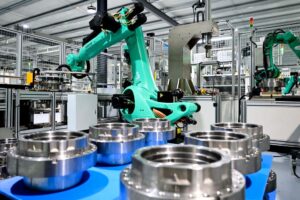In 2023, a total of 239 enterprises specializing in the comprehensive utilization of recycled resources such as waste steel, waste paper, and waste power batteries from new energy vehicles were selected. Throughout the year, the comprehensive utilization of waste power batteries from new energy vehicles amounted to 225,000 tons, essentially achieving the goal of collecting and utilizing all available waste batteries.

On January 19, at the press conference on industrial and information technology development held by the State Council Information Office, Xin Guobin, Deputy Minister of the Ministry of Industry and Information Technology, introduced the breakthrough progress made in China’s automotive industry in 2023.

- In 2023, new energy vehicles (NEVs) continued to lead the global market, with a comprehensive utilization of 225,000 tons of waste power batteries throughout the year. Specifically, for the first time, the production and sales of automobiles exceeded 30 million units, reaching 30.161 million and 30.094 million units respectively, marking a historic high with an increase of 11.6% and 12% year-on-year. After reaching 29 million units in 2017 and experiencing a decline in subsequent years, last year’s breakthrough maintained China’s global leadership in automotive production for 15 consecutive years. The automotive retail sales reached 4.86 trillion yuan, accounting for 10.3% of the total retail sales of consumer goods, with the value-added of the automotive manufacturing industry growing by 13% year-on-year.
- New energy vehicles continued their global dominance in 2023, with production and sales of 9.587 million and 9.495 million units, respectively, representing year-on-year increases of 35.8% and 37.9%. NEVs accounted for 31.6% of total vehicle sales, highlighting their market penetration. Advanced technologies such as semi-solid-state batteries with an energy density of 360 Wh/kg achieved vehicle applications last year, with new products showcased at the Shanghai Auto Show in April. The performance of automotive-grade high-computing-power chips has significantly improved, integrating various advanced technologies and becoming popular in major auto shows.
- Automotive exports also reached new heights, with 4.91 million units exported last year, a year-on-year increase of 57.9%, potentially making China the world’s top vehicle exporter for the first time. NEV exports totaled 1.203 million units, up 77.6% year-on-year. Power battery exports reached 127.4 GWh, a year-on-year increase of 87.1%.
Xin Guobin acknowledged the achievements while also recognizing challenges such as subdued consumer demand, trade protectionism in some countries and regions, industry-specific issues, profitability concerns for most NEV companies, and shortcomings in areas like automotive chips. Moreover, there are issues in the development of intelligent connected vehicles, with insufficient vehicle-road coordination and some traditional mindsets hindering progress. Unordered competition and blind, redundant construction of new energy vehicle projects in some areas also need attention.
Regarding the sustainability of this growth momentum and measures for high-quality industrial development in 2023, the Ministry of Industry and Information Technology conducted research earlier in the year, analyzing the development environment, constraints, and favorable factors. The industry association’s findings are optimistic, predicting stable growth for the automotive industry in 2024, with NEV sales expected to reach around 11.5 million units, a 20% increase.
The next step, the Ministry of Industry and Information Technology will conscientiously implement the Central Economic Work Conference and the National New Industrialization Promotion Conference work deployment, together with the relevant departments to further strengthen the macro-guidance, strengthen the industry management, and promote the high-quality development of the automobile industry.
- First of all, we should implement and implement the preferential policies such as vehicle purchase tax reduction and exemption, carry out the pilot of comprehensive electrification of public sector vehicles and new energy vehicles to the countryside, actively expand the consumption of new energy vehicles, and keep the industry running stably. Last year, the Ministry of Industry and Information Technology carried out a total of six new energy vehicles to the countryside activities. While expanding the rural market, it also led to the construction of rural charging and switching infrastructure, further improving the consumption experience of rural consumers.
- Secondly, it is necessary to support enterprises to carry out joint innovation, increase automotive chips, all-solid-state batteries, high-level automated driving and other technology research, and further enhance the competitiveness of the product market.
- Thirdly, we should organize and carry out the access to intelligent networked vehicles and the pilot application of “vehicle, road and cloud integration”, accelerate the construction of infrastructure such as road-side sensing, network cloud control, and further improve the standard system of vehicle-side, road-side and network-side, and further promote the commercialization and application of intelligent networked vehicles.
- Fourth, further strengthen the integrated layout of industrial development, prevent and resolve the risk of overcapacity, and maintain a fair and competitive market order. The automobile industry is an internationalized industry, and in the course of this year’s development, MIIT will also continue to promote internationalized development, advocate collaborative innovation and globalized development, and promote the elimination of various forms of trade protection policies, so as to create a good international and domestic environment for industrial development.

In terms of green and low-carbon achievements in 2023 and future key tasks and measures, Tao Qing, spokesperson for the Ministry of Industry and Information Technology and Director of the Operation Monitoring and Coordination Bureau, reported that 239 companies specializing in comprehensive utilization of waste steel, waste paper, and waste power batteries from new energy vehicles were selected in 2023. The annual comprehensive utilization of waste power batteries from NEVs reached 225,000 tons, achieving the goal of collecting as much as possible. The home appliance industry achieved a recyclable utilization rate of over 80% for products like refrigerators, washing machines, and air conditioners through recyclable and disassemblable designs.
In 2023, the Ministry diligently implemented Xi Jinping’s ecological civilization thought and the directives of the national new industrialization advancement conference, promoting industrial green and low-carbon transformation with positive results:
- Continuous optimization of industrial structure, with accelerated green and low-carbon transformation and upgrading. Backward capacities in steel, electrolytic aluminum, petrochemical, and building materials industries were further reduced. Seventy-eight steel companies completed ultra-low emission transformation for 390 million tons of crude steel capacity, and the intensity of major pollutants and CO2 emissions in key industries continued to decline.
- Accelerated release of green momentum. Continued construction of a green manufacturing system, increasing the cultivation of advanced models. By the end of 2023, 5095 green factories were established at the national level, accounting for over 17% of the total manufacturing output value. The world’s largest 16 MW offshore wind turbine successfully connected to the grid, and the photovoltaic industry chain maintained its global lead in major segments. The development of green and intelligent coastal and inland river ships accelerated. The first 10,000-ton green hydrogen industrialization demonstration project was completed and put into operation. The annual total output value of the environmental protection equipment manufacturing industry is expected to exceed 970 billion yuan.
- More efficient use of energy and resources. The energy efficiency level of key energy-consuming industries continued to improve, with the capacity ratio of industries like ethylene reaching benchmark energy efficiency levels exceeding 30%. The annual reuse rate of industrial water for large-scale industries is expected to surpass 93%. The energy efficiency of information infrastructure also continued to improve, with 196 green data centers cultivated by the end of 2023.
- Further improvement of the industrial resource comprehensive utilization system. In 2023, 239 companies specializing in comprehensive utilization of waste steel, waste paper, and waste power batteries from new energy vehicles were selected, achieving the annual comprehensive utilization of 225,000 tons of waste power batteries from NEVs. The home appliance industry achieved a recyclable utilization rate of over 80% for products like refrigerators, washing machines, and air conditioners through recyclable and disassemblable designs.
Next, the Ministry will continue to advance the “14th Five-Year Plan for Green Industrial Development,” continuously enhancing the green content of new industrialization and polishing the ecological bottom line:
- Actively and steadily advancing industrial carbon reduction. Coordinating industrial and key industry peak carbon efforts and carrying out industrial digital carbon management pilots. About 100 key product carbon footprint rule standards are planned for 2024. Vigorously developing hydrogen energy, energy storage, and other green and low-carbon industries, raising backward capacity requirements for energy consumption and environmental protection, and accelerating pollution reduction and carbon reduction synergistic efficiency improvement.
- Focusing on building a green manufacturing and service system. Deeply implementing the green manufacturing project, aiming to cultivate 1000 new green factories at the national level in 2024, perfecting the green manufacturing service system, and piloting the implementation of “enterprise green codes.” Fully leveraging the national industrial and financial cooperation platform, actively creating green consumption scenarios in areas like new energy vehicles and green home appliances.
- Vigorously improving industrial energy and water efficiency. Promoting energy efficiency improvement in key industries and key energy-consuming equipment like motors and transformers, accelerating the construction of industrial green microgrids in key industries and fields, releasing the 2024 energy and water-saving technology equipment recommendation catalog for the Ministry of Industry and Information Technology, and continuously creating energy and water efficiency “leader” enterprises.
- Comprehensively promoting efficient resource utilization. Accelerating the construction of a waste recycling system, encouraging eligible regions to create “waste-free parks” and “waste-free enterprises.” Promoting the standardized development of the comprehensive utilization industry of renewable resources, aiming for a stable increase in the comprehensive utilization of major types of renewable resources in 2024, improving the emerging solid waste utilization system, and striving to achieve an annual comprehensive utilization of over 260,000 tons of waste power batteries.
Source: Battery People – Electric Battery Network (itdcw.com)



